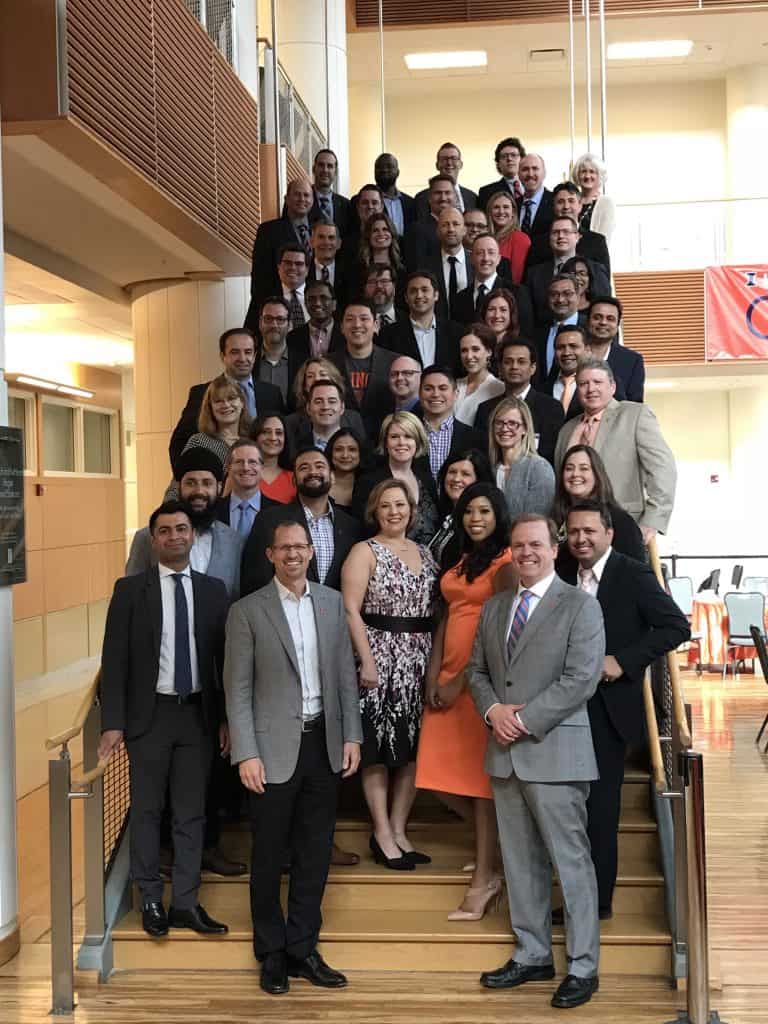Coursera CEO and UIUC Business School Dean Believe Value and Student Experience Drive iMBA’s Success
Coursera’s CEO Jeff Maggioncalda and Dean of the University of Illinois Gies College of Business Jeffrey Brown sat down with Class Central’s founder Dhawal Shah to reflect on the program
With so many degree programs now being launched through the major MOOC platforms, it’s easy to forget that MOOC-based degree programs are only a few years old. One of the first of these degrees to hit the market was the iMBA from Coursera and the University of Illinois Urbana-Champaign, announced in mid-2015. It has around 1100 students enrolled and the first cohort of 76 iMBA students has graduated from the program. They received their degrees on May 13th at an in-person graduation ceremony on the Urbana-Champaign campus.
On the occasion of the first iMBA graduation, I (Class Central’s founder Dhawal Shah) sat down with Coursera’s CEO Jeff Maggioncalda and Dean of the University of Illinois Gies College of Business Jeffrey Brown to reflect on the program and to discuss how it is influencing online learning in particular and higher education in general.
P.S. Laurie Pickard and I discuss the iMBA graduation here.
The conversation has been edited for length and clarity.
 Coursera CEO Jeff Maggioncalda on the left. Dean of the University of Illinois Gies College of Business Jeffrey Brown on the right.
Coursera CEO Jeff Maggioncalda on the left. Dean of the University of Illinois Gies College of Business Jeffrey Brown on the right.
Shah: To start off, could you tell us the story of how iMBA got started?
Brown: This university was one of 12 initial partners with Coursera, so we had gotten into MOOCs pretty early. I don’t really remember who approached who, but we started having conversations [about the potential for a MOOC-based degree]. The former dean formed a steering committee to figure out what do we want to do in this space, and I was on that committee. We were kicking around all kinds of ideas. Do we want to do something in the Bachelor space? The Master space? Do we want to do a whole new degree? Do we want to do something in an existing degree space? Ultimately, we decided if we were gonna do this, we should be bold, and we should enter the MBA space. Once we made that decision, things moved really fast. It was a matter of months before we had managed to get all the internal campus approvals. So I would say it was really the partnership that came first, then the idea of doing a degree, and then ultimately we converged on the idea of making it an MBA.
Maggioncalda: But we didn’t have a degree platform, of course, then. We had a MOOC platform, which is a far cry from what is needed. Even now, there are still a lot of gaps. If you talk to students, they love it, but it’s not perfect. I think about the entrepreneurship of the school and of the students who said, “You know what? We’re gonna blaze the trail here.” It doesn’t come out without a couple of bumps and bruises, but boy, it’s sure a wonderful payout.
Brown: It was like a lot of startups. You start with a wonderful idea and a business plan that, in retrospect, was not completely right. You figure it out as you go. People keep saying, “Oh, do you have any big changes in mind?” We’re like, “We’re constantly improving this thing.”
 iMBA graduates with Coursera CEO Jeff Maggioncalda and Dean of the University of Illinois Gies College of Business Jeffrey Brown. src: Coursera
iMBA graduates with Coursera CEO Jeff Maggioncalda and Dean of the University of Illinois Gies College of Business Jeffrey Brown. src: Coursera
Shah: How did you approach redesigning your degree program for online delivery? I understand you largely created the iMBA using internal talent.
Maggioncalda: It was easier for us because we knew that we were in the startup game. But to take the same team that’s been doing something similar for a long time and to reinvent the design and delivery of a course, that’s quite dramatic.
Brown: I give huge credit to the faculty, people who had been masters of their craft in the classroom for years. We put them in this environment where everything was different. They were part of a team now. They no longer had complete control over everything that happened in their class. They had to work with instructional designers and videographers and e-learning experts to think differently about how you were gonna grade folks, how you were going to deliver concepts. You had to start thinking about how you break the course down into these small pieces that could be sufficiently self-contained, yet still, cover the material. It was not easy for them. Some of them kind of did a little bit of kicking and screaming early on, but a lot of those same people are now the biggest advocates of this program. Because once they learn it, they realize the power of this medium, and that there’s actually a lot you can do in the online space that you can’t do in the face-to-face classrooms.
Shah: What have you learned from the iMBA that might influence other MOOC-based degree programs?
Maggioncalda: One thing the University of Illinois has done a lot with is live video seminars. I don’t know how many schools are going to be able to do that. Some may follow, but that’s like black diamond difficulty stuff. You might have 300 people in a video session, but you start learning how to do polling and how to raise a hand. Then you get a TA moderating the Slack channel. People start learning how to do it. I think ideally, that will become a part of those degrees where live interaction with the expert faculty is valuable. That was something you guys pioneered right out of the gate, and it was pretty audacious.
Brown: It’s become a really important characteristic of the program. The iMBA students feel like they are really a part of this place. They’ve got access to the faculty here. It’s what I think really differentiated this program from, the online programs from ten years ago when it was just a boring voice-over of a PowerPoint. We’ve completely destroyed that old model. This is an interactive, engaging experience for the students, and that’s why we have a 92 percent plus retention rate. They’re forming relationships with the faculty. They’re forming relationships with other students in the class. A lot of people didn’t think we’d be able to pull that off.
We went into this from the beginning, saying, “We want to offer something that’s an incredible value.” The whole idea that we’re able to provide an MBA from one of the top universities in the world for $22,000, that was pretty earth-shattering, right? One of the lines we now use is, “The students came for the price but they stayed because of the experience.” What we’ve provided, I would put up against any online, any face-to-face program in the world. And yet, we’re providing it at this incredible price point.
Shah: So, what would you say differentiates this program from your on-campus program?
Brown: We have really tapped into a whole different market here. Most of our students are full-time professionals at the peak of their careers. They’re in their mid 30s, 40s. They’re in a job. They cannot career-wise afford to quit their job for two years and go back and study. Many of them are raising families. Many of them are from countries where it would just not even be possible for them to come here and study. So we’ve really created a product that has made an MBA possible for a whole group of highly talented people who probably who never would have gotten one.
In our on-campus program, we do a lot of what we called experiential learning, client-based projects and those sorts of things. Part of what I love about the online program is that it’s forced us to think about what is unique about a residential experience and then translate it into a digital experience.
Maggioncalda: It turns out the lectures are not the most unique part. I heard somebody say that in the past, higher education was about delivering content and a diploma at the end. But now and in the future it’s going to be much more about delivering an experience. Students are creating close relationships and they’re learning things that will advance their ability to progress in their jobs.
Shah: One last question, how do you think about scale with respect to this program?
Maggioncalda: I think about systems. As the system gets bigger, where would the bottlenecks emerge? My sense is that the bottlenecks will emerge in live sessions and in grading. That’s my guess. The grading, I’m actually not so concerned about because I think the ability to automate grading at scale will become pretty good. The live sessions get tricky. From a technology perspective, I’m not that worried about it. It’s the professor’s time and attention. My thought is it’s going to be a little bit like pyramid, where the number of hours that the main professor puts in won’t really change. If you think about how medical systems have worked, a doctor is in the system, but the number of minutes and hours that a doctor spends [with each patient] becomes an increasingly smaller portion of the total time [during which medical treatment is being delivered]. I think it will probably be somewhat similar for education. The size of the classes could be big, let’s say 10,000. But that will be broken into sections of say 50. And each of those sections has an expert who’s probably not the professor. Also, there will be a lot more collaborative learning among the peers in the class. If you think about it, a lot of learning does actually happen among the folks in a class. The expert just dispensing wisdom is not the way most learning happens. I call it “high engagement learning at scale.” A major piece of high engagement learning at scale is utilizing your classmates to provide a highly valuable learning experience.
Shah: So do you think it actually gets better the more people you have?
Maggioncalda: My guess is it will be really good when it’s small. Then it will be tough as it’s growing. And once we break through with a design and the data, it will become good again. My guess is that in the range of 1,000 to 5,000, it’s going to be pretty tricky. But I think we and our partners will eventually have a set of tools and algorithms and technologies, as well as pedagogical design that can be scaled. But we don’t know the answer to this one yet.







Jeff Cady
Current iMBA student here… I think it’s important to note that it’s not the iMBA vision to go to 10,000 students. While Coursera is a venture-backed organization focused on scale and profit maximization, Illinois is a nonprofit, land grant institution. The iMBA staff are very focused on finding a balance between growth and quality.
Dilrukshi Gamage
I wonder if they look for means of scaling but grouping that you dont feel the scale.
At the same time Maggioncalda:, said this course is more interactive and engaging, Im not sure how is it only the live video which tend to ask questions and in slack with TA’s or is there any other ways students interact with each other than forum?